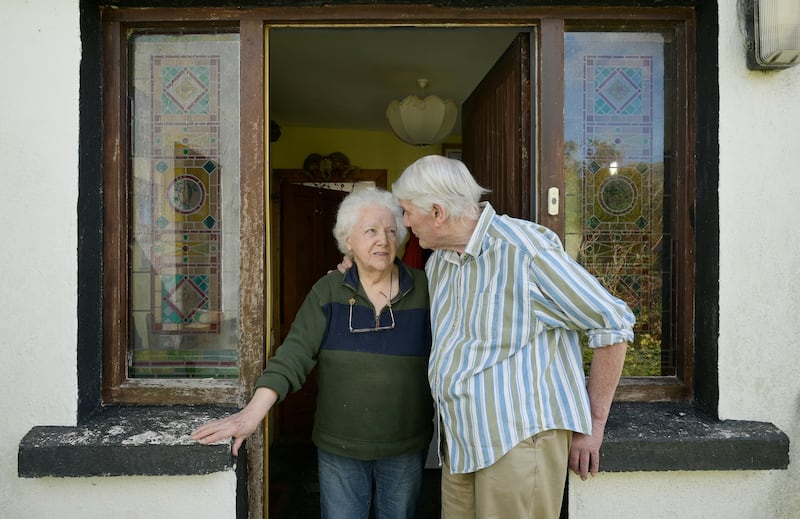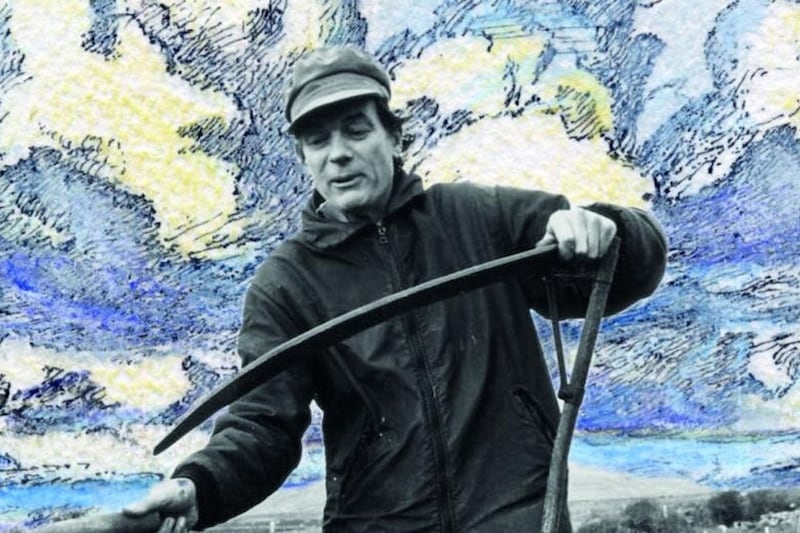Born: February 6th, 1933
Died: May 30th, 2023
Michael Viney, nature writer, illustrator, journalist and long-time Irish Times columnist, has died aged 90. His Another Life column, written and illustrated from his home in Thallabawn, Co Mayo ran on Saturdays, and was enduringly popular with loyal readers throughout the decades.
The column began in 1977, the year he, his wife Ethna and their daughter Michele moved from Dublin to Co Mayo, to live a life of self-sufficiency on their small farm of one acre under Mweelrea mountain. The initial years recorded the family’s day-to-day challenges with growing their own food, living a sustainable life, and caring for their animals and poultry.
RM Block
The focus of Another Life shifted after a decade or so to the observation, celebration and inquiry into the natural life that sang and grew and swam and thrummed all around them in their little part of rural Ireland. Each column was accompanied by an illustration in watercolour pencil, made in Viney’s distinctive, precise style.
The years passed and The Irish Times switched to colour. Seven editors of the paper have come and gone since 1977, and through all this time, Viney’s columns continued to steadfastly appear on Saturdays. His final column appeared in February of this year.
Michael Viney was born on February 6th, 1933, in Brighton, England, where his parents ran a fast-food cafe. Aged 16, he joined the local weekly paper, the Brighton and Hove Herald, as a trainee reporter. He was apprenticed at 21, and then joined the Evening Argus as a reporter and features writer. From there, he went to London and worked for The Star evening paper, now defunct. In addition, he contributed to Today, a weekly magazine, also now defunct.
By the age of 28, he had saved up enough money to take a year off, and chose to spend it in the west of Ireland, despite not knowing anyone there. He cycled his bike across Ireland to Connemara, rented a cottage, and spent a year painting, writing and birdwatching.
His first article for The Irish Times appeared on May 29th, 1962, eight months into this experimental year, where he noted: “I am older than I thought, and know less.”
When his savings began to deplete, he went to Dublin, and sold his bicycle to generate extra money. Dublin was meant to be a stopping point back to London. He never returned there to work. He stayed for a while with Joe O’Donnell, a friend working in RTÉ; and the then features editor of this newspaper, Jack Jones, commissioned articles from him.
In 1965, he married Ethna McManus, whom he had met the previous Christmas when they were getting a lift from a mutual friend. They were to form a singular partnership both in their lives and professional careers, collaborating on many projects.
The initial Irish Times freelance work turned into a number of series, many of them unusually long and in-depth for their era. Douglas Gageby was the then editor, and Viney credited him with being permitted “remarkable freedom and work time for my own choice of social inquiries”. Among the subjects of those series were: the future of the Irish language; mental health; and an increase of non-residents, particularly Germans, buying land and property in the west of Ireland.
In the early months of 1964, Gageby asked Viney to travel through Northern Ireland, with a view to gathering reflections from people on what shape their future there might be taking. The series was to be called Journey North. One of the people he met while reporting was a young Derry-born teacher called John Hume, then aged 26 and actively involved in cross-cultural activities. Hume was also in the process of founding a housing association in Derry, along with a credit union.
On return to Dublin, Viney alerted Gageby to Hume’s presence and proactive activities. As a result, Gageby offered Hume an opportunity to contribute his opinions to The Irish Times, on how Northern Ireland was evolving. It was the start of an ongoing engagement between Hume and Gageby, as efforts continued towards peace and powersharing.
But by far Viney’s most famous and influential piece of work for The Irish Times from that period was an eight-part series on young offenders, which ran in 1966.
That year, he went to industrial and reformatory schools, including St Conleth’s at Daingean in Co Offaly, and interviewed the boys and staff. At that time, the public either knew nothing, or said nothing, of the abuse that was happening countrywide in such institutions. Writing about the conditions the boys lived in at Daingean, Viney quoted one boy, 17-year-old Larry, who said starkly of the refectory: “I’d like a bit of cleanliness down there. The rust does sometimes be thick on the knives.”
Larry also talked about multiple floggings, always being hungry, countless fruitless attempts to run away, followed by more beatings, a shower once a month and being forced to work in the fields in winter, with “so little clothes on you, just the little short coat”.
The series provoked no public outcry nor investigations at the time, but they remained on the written record. As Fintan O’Toole stated last year: “They had potent afterlife as cross-sections of Irish life at a time of epochal change. The Ryan report on the industrial school system appends Viney’s contemporary reports as essential historic documents.”
In 1976 Viney left The Irish Times to work for RTÉ as a production editor. He spent one year there. The desire for an independent, rural-based life which had pulled him from his media career in London to Connemara in 1961, now exerted a similar pull. In 1972 the Vineys had bought a former Land Commission cottage in rural Co Mayo, and used it for holidays. By 1977, they decided to leave Dublin and live permanently in the west.

A fortnight before they departed, Viney ran into his former editor, Douglas Gageby, on Grafton Street. In an interview in 2013 to mark his 80th birthday, Viney stated: “He said we’d be back within six months but that meantime would I write a weekly column. It just never occurred to us at any point that we wouldn’t stay. I wanted to live a more immediate life, but I had to learn how to do it. I love making things grow and watching things grow. But it’s just as well we didn’t leave it any later to move than our 40s, because I don’t think we would have had the physical stamina to do what we did later on.”
For many years, Viney, who never learned to drive, cycled 5km on Mondays, winter and summer, through storms and sunshine, to post off his column and drawing. Despite Gageby’s prediction, they never returned to Dublin. They raised goats, ducks, hens and geese. They grew an abundance of vegetables and fruit. Viney recorded the seasons, the harvesting, the challenges and joys of their rural life.
The column was immediately popular with readers, who experienced vicariously the Vineys’ ongoing life of self-sufficiency on their Mayo acre. It generated many letters to their home over the years, and sometimes curious visitors in person.
In his 2013 interview, he recounted that when Conor Brady became editor, Viney went to meet him in Dublin, to discuss the future of his column. Brady asked him: “Why don’t you write about nature?” It was an unerringly prescient suggestion. Nature writing in all its many forms was Viney’s focus for the rest of his long career as a columnist.
In that interview, Viney also said: “I’ve had this strong sense of curiosity all my life. That’s what’s driven me as a journalist. And nature is full of infinite surprises and amazing detail. I have to produce a column every week and I can’t write a column about something if I’m not interested.”
In later years, with the arrival of the internet, bicycle journeys to the post office were no longer necessary. He emailed his column on a Wednesday, together with scans of his drawings.

Michael Viney was elected to Aosdána in 2007, and as a member of the Royal Irish Academy in 2017.
The editor of The Irish Times, Ruadhán Mac Cormaic, said Michael Viney was a remarkable journalist whose work would have lasting influence. “As a social affairs reporter, his early writing on Ireland’s industrial schools was the first draft of a terrible, at the time still unwritten, history.
“The poise and sensitivity he brought to his reportage would later mark his writing on the natural world – the subject of a column that ran in The Irish Times for 45 years until his retirement in February. In that slot he pioneered a new genre, his deep concern for biodiversity, climate action and sustainable living lighting the path for others to follow. Another Life started out as an account of Michael’s move to the west with his wife, Ethna, and their daughter Michele. Latterly, the title seemed to stand for something else: the promise of a better future in which mankind heeded warnings from nature.”
Michael Viney was an atheist, a fact he repeated many times. “Nothing comes after,” he always said.
In his last column, which appeared on February 4th of this year, he wrote: “On the eve of my 90th birthday, I’m already too wobbly to wade the river in the strand. So this, with apology, is the last Another Life, my long-extended chronicle of a change in family lifestyle and exploring the natural world.
“I close with a fond memory... On a fine spring day, I’m lying on my back with binoculars raised, watching my first-ever skylark soaring, singing and improvising. It rises, ever smaller, in the blue, to an ultimate, resonant speck of life.”
He is survived by his wife Ethna, and his daughter Michele.


















